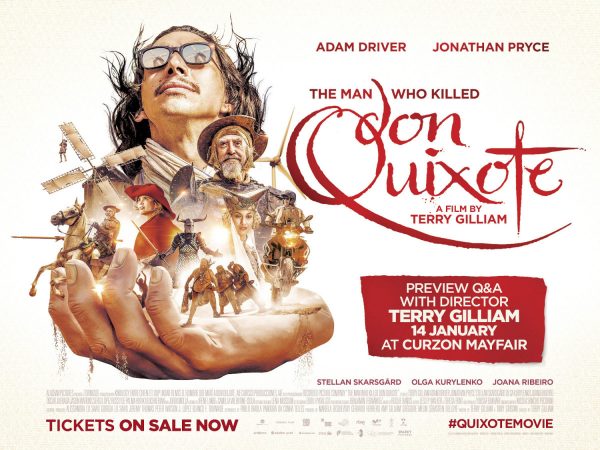The Man Who Killed Don Quixote, 2018.
Directed by Terry Gilliam.
Starring Adam Driver, Jonathan Pryce, Stellan Skarsgård, Olga Kurylenko, Jason Watkins, Joana Ribeiro, Jordi Mollà and Sergi López.
SYNOPSIS:
An advertising director returns to the Spanish village where he made a student film adaptation of Don Quixote, only to find his star now believes he is really the literary hero.
It’s impossible to discuss Terry Gilliam’s bizarre The Man Who Killed Don Quixote without first mentioning its arduous, circuitous path to the big screen. Director Terry Gilliam has been trying to make his take on the iconic Miguel de Cervantes novel for more than 30 years, with Johnny Depp, Ewan McGregor, Michael Palin, Jack O’Connell and Robin Williams all at one stage cast in one of the two lead roles. So lengthy has the process been that Lost in La Mancha – a documentary about the troubled production – is now itself almost 20 years old. Finally though, Gilliam has made it and, for better or worse, it’s now on its way into cinemas.
Toby (Adam Driver) is an advertising director, struggling in Spain at the helm of an ambitious ad based on the classic tale of Don Quixote. His boss (Stellan Skarsgård) introduces him to a local who’s flogging bootleg DVDs including, weirdly, Toby’s student film The Man Who Killed Don Quixote, in which he cast local cobbler Javier (Jonathan Pryce) as his hero. He goes to visit the village and finds that, since he left, Javier has become convinced he is the real Don Quixote – with Toby as his squire, Sancho – and, through a series of contrivances, the pair end up on a journey together.
 This is a deeply, deeply frustrating film. At some point over the course of this 30-year odyssey, Gilliam appears to have entirely lost sight of the movie he once wanted to make. In fact, it feels like the result of a grand game of Chinese Whispers, with the outcome a garbled tangle of story threads that never coalesce into anything meaningful or even coherent. There’s no denying the fact the movie has ideas, but that’s all it has – a few scribbles and post-its on a flipchart.
This is a deeply, deeply frustrating film. At some point over the course of this 30-year odyssey, Gilliam appears to have entirely lost sight of the movie he once wanted to make. In fact, it feels like the result of a grand game of Chinese Whispers, with the outcome a garbled tangle of story threads that never coalesce into anything meaningful or even coherent. There’s no denying the fact the movie has ideas, but that’s all it has – a few scribbles and post-its on a flipchart.
Quite simply, The Man Who Killed Don Quixote is a nonsensical mess. Scenes and story threads seem to have been assembled in a random order, solely to move the film from one expensive-looking locale to the next. It’s incompetent on a very basic level – an ugly, misshapen movie with very little to say beyond a series of tired comic set pieces. Women are thrown aside as either ineffectual or naive, with almost every female character treated as either an actual or potential sexual partner for Driver’s character.
Driver, on the heels of a terrific year in movies big and small, is completely at sea amid the nonsense of Gilliam’s vision. He largely yells his way through the uninspiring script as if desperately hoping someone will hear his cries, fly over in a helicopter and pluck him from the set of this nightmare. Ewan McGregor, Jack O’Connell and Johnny Depp will likely be counting their blessings that they never managed to get as far as Driver. Pryce is better as the other lead, but there’s too much broad, politically incorrect comedy on his part and not enough of the fragile human being beneath the slapstick and delusion.
Indeed, there isn’t a single character in the movie who feels as if they exist outside of their purpose as a comic cog in Gilliam’s spluttering machine. And the machine is exhausting, clanking and clanging for more than two hours through an aimless, meandering plot. Its obscene length and narrative lack of direction could be forgiven if Gilliam provided characters with depth for the audience to enjoy their company, but these are bland avatars for attempted comedy rather than believable human beings with palpable personalities.
It seems a shame to kick The Man Who Killed Don Quixote. This is the sum total of several decades worth of work from a man who was once one of the most exciting and enjoyable voices in comedy and cinema, but it has none of his energy and vigour. It’s a movie that proves there are some projects which struggle for a reason and those involved should have admitted defeat years ago. A cheeky on-screen message at the beginning reads “and now… after more than 25 years in the making… and unmaking”, as if we’re all supposed to cheer its arrival. It should have stayed unmade.
Flickering Myth Rating – Film: ★ ★ / Movie: ★
Tom Beasley is a freelance film journalist and wrestling fan. Follow him on Twitter via @TomJBeasley for movie opinions, wrestling stuff and puns.















